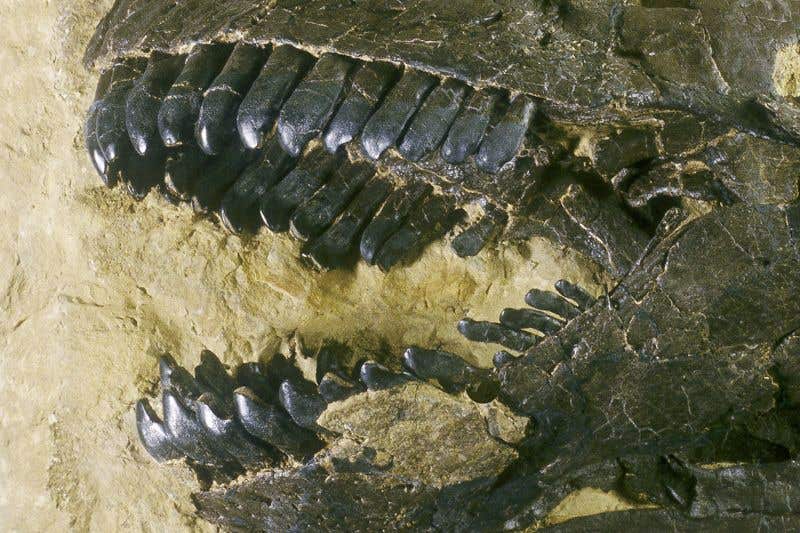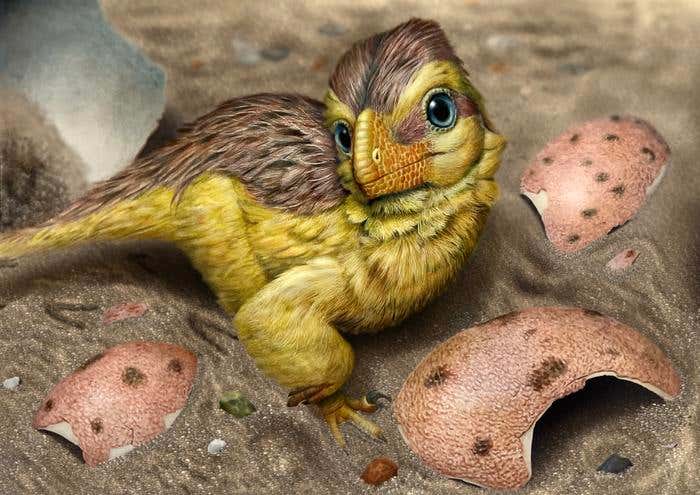Fossilized dinosaur teeth reveal atmospheric CO2 levels from the Jurassic and Cretaceous periods
Scientists use dinosaur teeth enamel to uncover ancient CO₂ levels and plant growth, offering new insight into Earth’s climate past.

Camarasaurus teeth from Howe Ranch, Wyoming. (CREDIT: Photo courtesy of the Sauriermuseum Aathal)
Dinosaurs may have vanished millions of years ago, but their teeth still carry a message from Earth’s distant past. A team of scientists from the Universities of Göttingen, Mainz, and Bochum has shown that tooth enamel, one of the most durable materials in the body, can hold chemical fingerprints that reveal what the atmosphere was like when these giants roamed the planet.
Instead of relying only on marine sediments or ancient soils to piece together past climates, researchers are now using oxygen isotopes preserved in dinosaur teeth. This new approach provides a rare glimpse into atmospheric carbon dioxide and global plant growth during the Jurassic and Cretaceous periods.
A Breath Locked in Enamel
The study focuses on the isotope anomaly of oxygen, known as Δ’17O. When animals inhale oxygen, its isotopes—atoms of oxygen with slightly different weights—enter the body. These isotopes carry a distinct signature shaped by the balance between atmospheric carbon dioxide and the world’s plant life. Every breath a dinosaur took left traces in its body water, which became sealed into tooth enamel as the teeth grew. Because enamel resists chemical change, it preserves these signals for millions of years.
The team analyzed enamel from teeth discovered across North America, Africa, and Europe. Fossils included massive sauropods like Giraffatitan and Camarasaurus, predators such as Tyrannosaurus rex and Albertosaurus, and plant-eaters like Edmontosaurus. Enamel and dentine, the softer tissue beneath it, were compared, but only enamel reliably preserved the original signal. Any samples showing later chemical alteration were carefully filtered out.
Reconstructing Ancient Carbon Dioxide
The measurements revealed strikingly high carbon dioxide levels compared with today. Around 150 million years ago, in the Late Jurassic, the air held about 1,200 parts per million (ppm) of CO₂—three times higher than preindustrial levels.
By the Late Cretaceous, about 70 million years ago, average levels had dropped to around 750 ppm, still roughly double preindustrial values. These findings line up with results from older methods, boosting confidence in this fresh technique.
Related Stories
- How did the T. rex’s bite force compare to the largest carnivorous dinosaurs
- Dinosaur fossils could hold the cure to cancer, study finds
Some teeth, however, recorded much higher concentrations. A T. rex tooth suggested nearly 1,800 ppm, while one Jurassic sauropod sample pointed to an extreme 3,000 ppm. These spikes may represent short bursts of volcanic activity, such as the massive eruptions of the Deccan Traps in India, which scientists already link to dramatic climate changes near the end of the Cretaceous.
Methodological Strengths and Limitations
The enamel isotope method carries uncertainties. The main challenge is not knowing the exact productivity of Jurassic and Cretaceous ecosystems. Because Δ’17O responds to both CO2 and productivity, researchers must either assume modern productivity levels to calculate CO2 or use independent CO2 estimates to back-calculate productivity.
Either way, the results are constrained by this dual relationship. Another uncertainty comes from physiological variation among dinosaurs—differences in water intake, metabolism, or environment could shift the isotope values.
To address these concerns, the researchers compared enamel data against modern animals and cross-checked results with other proxies. They also excluded altered samples and performed sensitivity analyses. Overall, the enamel method produced estimates consistent with other lines of evidence, demonstrating its reliability as a new paleoclimate tool.
The Role of Plants in a Greenhouse World
The isotope method also allowed researchers to estimate how much carbon plants absorbed globally through photosynthesis, a measure known as gross primary productivity. The results showed that Earth’s ecosystems during the Mesozoic were more productive than today. In fact, plant growth in the Late Jurassic may have been about 20% higher than modern levels, while the Late Cretaceous could have been more than twice as productive.
That productivity helped feed ecosystems that supported massive plant-eaters and the predators that hunted them. Dense forests and abundant vegetation matched the greenhouse climate conditions, where higher temperatures and more carbon dioxide created lush, thriving landscapes.
Sorting Out Local and Global Influences
One challenge in this research is separating the global atmosphere from local environmental quirks. For example, the unusually high CO₂ implied by one T. rex tooth may reflect water sources enriched by evaporation in a dry setting, rather than the air everywhere at the time. By contrast, the Jurassic sauropod Kaatedocus siberi, which showed no such water-related anomalies, may have captured a genuine atmospheric surge caused by volcanic activity.
Despite such complications, the broader picture holds: Mesozoic Earth was a greenhouse world with fluctuating CO₂ levels, sometimes pushed higher by sudden events. The method appears sensitive enough to record short-lived spikes that lasted thousands of years, offering a finer-scale view than many older proxies.
A New Tool for Paleoclimate
Until now, most reconstructions of ancient climates relied on indirect evidence from marine sediments or fossil soils, each with drawbacks. Tooth enamel provides a new terrestrial record, one that comes directly from land-dwelling animals. This allows scientists to cross-check other methods and build a more complete picture of Earth’s past climate.
Lead author Dr. Dingsu Feng from the University of Göttingen described the advance with enthusiasm: “Our method gives us a completely new view of the Earth's past. It opens up the possibility of using fossilized tooth enamel to investigate the composition of the early Earth's atmosphere and the productivity of plants at that time. This is crucial for understanding long-term climate dynamics.” He added, “Long ago their teeth recorded the climate for a period of over 150 million years—finally we are getting the message.”
Practical Implications of the Research
The new enamel isotope method could transform how scientists study climate history. By offering direct records from land animals, it helps fill gaps left by older marine-based approaches. Understanding how carbon dioxide and plant productivity shifted in the past improves models of Earth’s climate system and how it reacts to major changes.
It also highlights how sudden CO₂ surges from volcanic activity can drive rapid warming, lessons that matter for today’s discussions of greenhouse gases.
Beyond climate science, this work deepens our understanding of how ecosystems supported giant animals in a greenhouse world, linking atmospheric chemistry to the rise and fall of dinosaurs.
Research findings are available online in the journal PNAS.
Note: The article above provided above by The Brighter Side of News.
Like these kind of feel good stories? Get The Brighter Side of News' newsletter.



